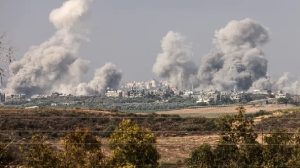29-04-2024
JERUSALEM/ GAZA CITY: News in the Middle East moves fast. One moment it is all about unprecedented missile and drone attacks between Iran and Israel. The next the headlines return to the fighting and suffering in Gaza but policymakers, analysts and military leaders are still absorbing the extraordinary exchange of fire just days ago between two old adversaries, one that arguably came a small technological failure away from triggering a devastating international conflict.
 It is worth considering how close they came to the edge and how deep the abyss that lay before them. This was the first time Iran and Israel had attacked each other directly.
It is worth considering how close they came to the edge and how deep the abyss that lay before them. This was the first time Iran and Israel had attacked each other directly.
Some analysts say the Iranian attack was the largest combined missile and drone assault ever bigger than anything Russia has levelled against Ukraine. It was certainly the first external bombardment of Israel since Saddam Hussein’s Scud missiles in 1991.
Most of the 300-plus Iranian drones and missiles were shot down or failed en route. But I watched from our office in Jerusalem as the night sky was lit up by Israeli air defences trying to bring down the ballistic missiles flying overhead. All it would have taken is for one GPS guidance system to fail for a missile to land in an urban area at huge civilian cost.
“I don’t think people realise how close we were that weekend,” one senior Western security official told me. “It could have been a very different story.”
Yet some in the West think positives can be drawn from the attack on 13 April and Israel’s limited retaliation last week. They argue it was a huge intelligence success to predict the Iranian strike, that the defence of Israel was an outstanding example of allied military cooperation, and that both Iran and Israel learned how to climb down the escalatory ladder.
 Let’s take the intelligence operation first. I am told the US learned about Iran’s plans on the Wednesday morning before the attack on Saturday evening. And crucially, they discovered the scale of Iran’s ambition.
Let’s take the intelligence operation first. I am told the US learned about Iran’s plans on the Wednesday morning before the attack on Saturday evening. And crucially, they discovered the scale of Iran’s ambition.
“We got wind that Iran’s response would be at the top end of expectations,” said one high-level Western source and “that was a bit of a shock but it helped galvanize the international response.”
Crucially, it helped the US persuade some countries in the Gulf to join in Israel’s defence, including Jordan and Saudi Arabia. Their fear once they were aware of the scale of Iran’s plans was the risk of an escalatory regional war if Israel had no choice but to retaliate hard. So a mixture of good intelligence gathering and private Iranian signaling (which the US denies took place) gave Israel and its ally’s time to prepare.
The roles played by Jordan and Saudi Arabia are still not fully clear. Jordan has admitted shooting down Iranian drones in self-defence to protect its sovereignty. It is understood Jordan also allowed Israeli warplanes some access to its airspace. The Saudis are thought to have provided information to the US and kept an eye on any threat from Iranian-backed armed groups in Yemen.
The key point is it worked. The US, British, French, Jordanian and Saudi militaries showed they could operate together on collective air defence.
“It was an extraordinarily successful tactical operation,” said the security source. “The intelligence cued it up, we had sight of the whole area and we worked together. No other group of nations can do that in the world.” Some have also argued this could be the start of a new regional alliance against Iran. (Int’l Monitoring Desk)
 Pressmediaofindia
Pressmediaofindia




